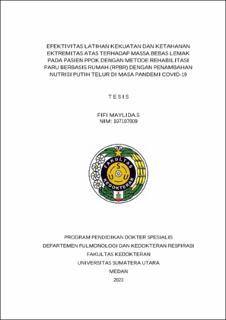| dc.contributor.advisor | Permatasari, Amira | |
| dc.contributor.advisor | Pandia, Pandiaman | |
| dc.contributor.author | S, Fifi Maylida | |
| dc.date.accessioned | 2024-03-28T04:42:50Z | |
| dc.date.available | 2024-03-28T04:42:50Z | |
| dc.date.issued | 2023 | |
| dc.identifier.uri | https://repositori.usu.ac.id/handle/123456789/92828 | |
| dc.description.abstract | Introduction : Chronic Obstructive Pulmonary Disease is a disease with permanent airflow obstruction associated with airway abnormality. Smoking is one of risk factors for COPD. COPD patients often experienced inability to do normal function due to a decrease in skeletal muscle functions. Skeletal muscles are often atrophied due to dysfunction and loss of muscle mass. Pulmonary rehabilitation is a great therapy to decrease activity limitations in COPD patients. Pulmonary rehabilitation may be done at home via telerehabilitation (home-based pulmonary rehabilitation / HBPR), especially during COVID-19 pandemic. One of the components in HBPR is upper extremity strength training. We are interested in discovering the effect of upper extremity strength training to fat free mass in COPD patients.
Methods : This is an experimental study in COPD patients at H. Adam Malik hospital starting from 07 September 2020 to 03 October 2020. Inclusion criteria is stable COPD patients with mild to severe symptoms and aged 40 – 70-year-old. Exclusion criteria includes patients with malignancy, severe neuromuscular and musculosceletal dysfunction, severe infection and sepsis, long term oxygen therapy, and patients with other training program. Subjects were examined before training and were given SABA inhaler along with online training videos. Subjects were instructed to consumed 7 egg whites after training. Training was done continuously for 4 week and subjects were re-examined. Data collected was analyzed with statistical software and presented in tables and figures.
Results : During study 15 patients were included, 93% is male. Most subjects (93%) were active smokers and 9 were categorized as heavy smokers. Significant correlation was found in body weight results before and after training, 64.09 ± 11.89 and 65.72 ± 10.65, respectively. Body fat was associated with training (p < 0.05); however, visceral fat was not related. Fat free mass after training was increased from 48.49 ± 6.55 to 49.69 ± 6.22 with significant association (p = 0.038). CAT score 10 or more that was gained by 73.3% (11 subjects) and mMRC Dyspnea Scale 2 or more was detected in 40% (6 subjects).
Conclusion : Upper extremity strength and endurance training accompanied by good nutrition intake may increase fat free mass and lessened symptoms in COPD patients. | en_US |
| dc.language.iso | id | en_US |
| dc.publisher | Universitas Sumatera Utara | en_US |
| dc.subject | Chronic Obstructive Pulmonary Disease (COPD) | en_US |
| dc.subject | Home-Based Pulmonary Rehabilitation (HBPR) | en_US |
| dc.subject | Upper Extremity Strength and Endurance Training | en_US |
| dc.subject | Nutrition | en_US |
| dc.subject | Free Fat Mass | en_US |
| dc.subject | SDGs | en_US |
| dc.title | Efektivitas Latihan Kekuatan dan Ketahanan Ektremitas Atas terhadap Massa Bebas Lemak pada Pasien PPOK dengan Metode Rehabilitasi Paru Berbasis Rumah (RPBR) dengan Penambahan Nutrisi Putih Telur di Masa Pandemi Covid-19 | en_US |
| dc.type | Thesis | en_US |
| dc.identifier.nim | NIM197107009 | |
| dc.identifier.nidn | NIDN0007116903 | |
| dc.identifier.nidn | NIDN0019056110 | |
| dc.identifier.kodeprodi | KODEPRODI11752#Pulmonologi dan Kedokteran Respirasi | |
| dc.description.pages | 117 Pages | en_US |
| dc.description.type | Tesis Magister | en_US |





